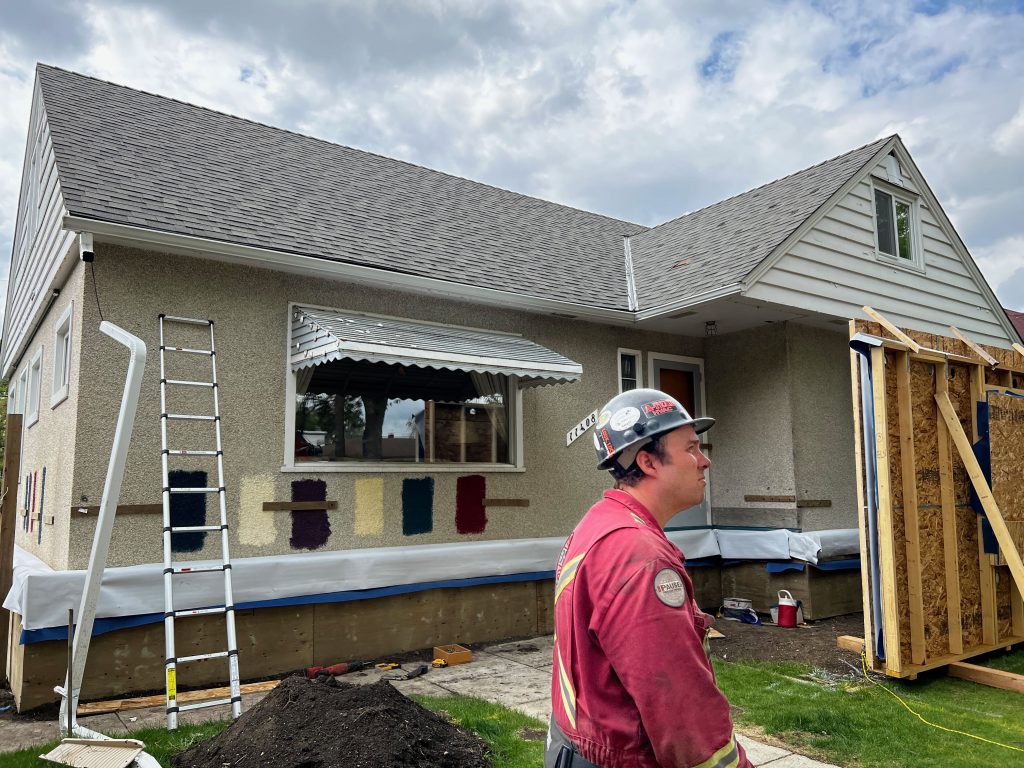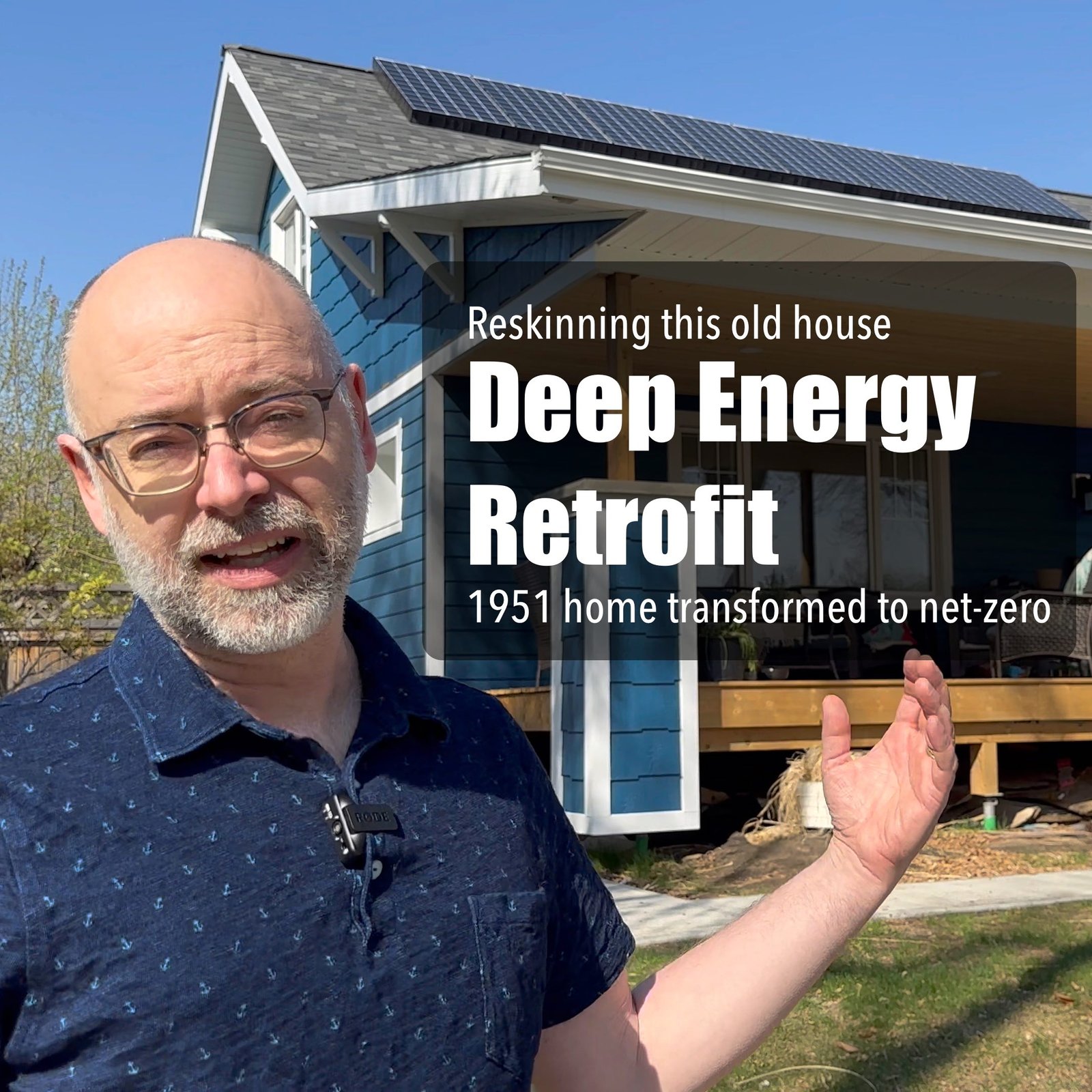By David Dodge, GreenEnergyFutures.ca
The Sandercock family bought a 1951 story-and-a-half home in the beautiful Highlands neighbourhood in Edmonton.
But they realized very early on that the post-war home was “bleeding a lot of heat” and “a lot energy was being wasted,” says Jim Sandercock.
“In the middle of summer, the second story is way too hot for the kids’ bedroom.
“So they sleep in the basement and then in the wintertime, the basement was way too cold and nobody goes down there.”
With wildly fluctuating energy prices, climate change and challenging severe weather impacts there is growing interest in increasing energy efficiency and taking charge of producing your own energy.
More and more people are considering building new net-zero homes, but what do you do with your old 1951 poorly insulated home?

Bulldozers need not apply
Dr. Jim Sandercock is the chair of the Alternative Energy Program at NAIT in Edmonton, so he knows a thing or two about the benefits of energy efficiency. As they began considering their options Sandercock also wanted to avoid bulldozing their old home.
“It’s got great bones and like a lot of houses that are old, there’s a whole bunch of embodied carbon and a whole bunch of value like hardwood and stuff.”
“We didn’t want to just throw it all away. And so what we decided to do is wrap an envelope, or a big giant tea cozy as Amery Lovins would say, and just plop that right on top of the house and make the house way more energy efficient. And we’re aiming to become net zero with a 1951 house,” says Sandercock.

EnergieSprong Deep Energy Retrofit
It turns out net-zero builder Peter Amerongen of Butterwick Projects was setting up a couple of projects to pilot the Dutch EnergieSprong retrofit strategy in Canada.
Amerongen is just completing the largest project of its kind in Canada, retrofitting the 59 homes of Sundance Housing Cooperative to net-zero in one project. He is also testing the idea in three single-family home retrofits.
So Sandercock and his family signed up to be one of three single-family homes that would pilot the deep energy retrofit strategy.
“We’re using a system called EnergySprong, which came out of the Netherlands…And EnergieSprong means ‘energy leap’ in Dutch.
“And basically what they’re doing is scanning the whole house, going offsite, taking those scans, and building new walls.”
Then the walls are literally lifted from a truck by a crane and they are installed right over the original walls and roof creating massive improvements in insulation and air sealing.
Heat Pumps 101
Net-Zero 101
59-unit retrofit to net-zero
Result – A super-insulated net-zero home
The improvement is dramatic. The old 2×4 walls are now 16 inches thick (see our video for details) taking the insulation levels from R12 to R40. The result is very similar to a double-studded wall used in many new net-zero builds.
The new 2×10 roof is stuffed with insulation and added over the old one dramatically increasing insulation there too.
Then using hydro vac equipment Butterwick Projects dug all the way down to the footing at the base of the foundation and added EPS insulation all the way up.

A bevy of heat pumps
Inside the home, the story is all about heat pumps. A cold climate heat pump will provide all the heat and cooling the home requires and the clothes dryer and water heater are also heat pump models. Heat pumps run on electricity and they are 200% to 400% efficient. A heat recovery ventilator is used to provide tons of fresh air in the air-sealed home and as importantly it recovers more than 70% of the heat from exhaust air.
The Sandercocks also replaced their natural gas stove with an induction stove, which is twice as energy efficient and is a much better-performing appliance.
How incentives promote regrettable incremental upgrades
Net-zero expert Peter Amerongen calls it regrettable incrementalism where small upgrades, often driven by incentives create unintended consequences.
“When you put a new [natural gas] furnace in, that will cost you $6,000 depending on your home. Those are lost dollars you could be putting into a whole home effort,” says Pamela Goertzen of the Smart Sustainable Resilient Infrastructure Association (SSRIA) who provided financial support for the three EnergieSprong pilot homes.
Jim Sandercock understands these risks all too well.
“There’s some danger in doing your renovations incrementally. You really want to have a good plan and we just kind of put a little insulation there and, oh, there’s a grant, let’s put a little solar there,” says Sandercock.
Sandercock added some insulation, replaced his shingles and added solar three years before they committed to their deep energy retrofit.
The solar had to be removed, and the shingles are now a sunk cost covered by the new roof.
The best way to avoid regrettable incrementalism is to review pathways to net-zero and ensure whatever upgrades you do contribute to progress on the pathway.
Amerongen says what’s needed are retrofit coaches who are embedded in the agencies offering incentives to help people make good decisions. He is also working on developing a library of case studies for deep energy retrofits at retrofit.ca.
As for the Sandercock retrofit. “It’s going really well. My poor bald head doesn’t feel so cold in the winter. Our upstairs is livable in the summer for our kids and they don’t have to sleep in the basement anymore,” says Sandercock.
And the coup de grâce is “We are making money on our utilities right at this time of year instead of having to pay.”

